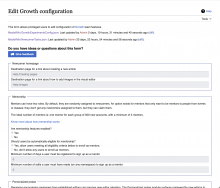The fundamental idea of community configuration is to store certain configuration settings as JSON pages in the MediaWiki namespace, so the full suite of MediaWiki curation, audit and authorization workflows naturally applies to them; but JSON (or in general, machine-readable text) is not a user-friendly interface, so we provide various forms to edit these pages in a highly structured way, and also to inject documentation and minor validation (e.g. existence checks for page names) into the editing process.
The code to do this is a bit messy, and in general it seems like a lot of manual effort to do form generation for every bit of configuration. It would be nice to generate a form automatically from validation rules (see T332847: [Spike] Investigate JSON structure validation options for community configuration for those), similar to how it's done for e.g. Special:ApiSandbox.
It would be even nicer if we wouldn't have to maintain a lot of form generation code. There are various third-party libraries for generating forms e.g. from JSONSchema, but we'd want native-looking forms, and customizability of the end result, so we are really looking for form descriptor generation. Let's investigate if there are appropriate libraries (ideally in PHP, but I think a fully client-side solution could also be viable here), and also spec out in more detail how "customizable form generation" could look.
